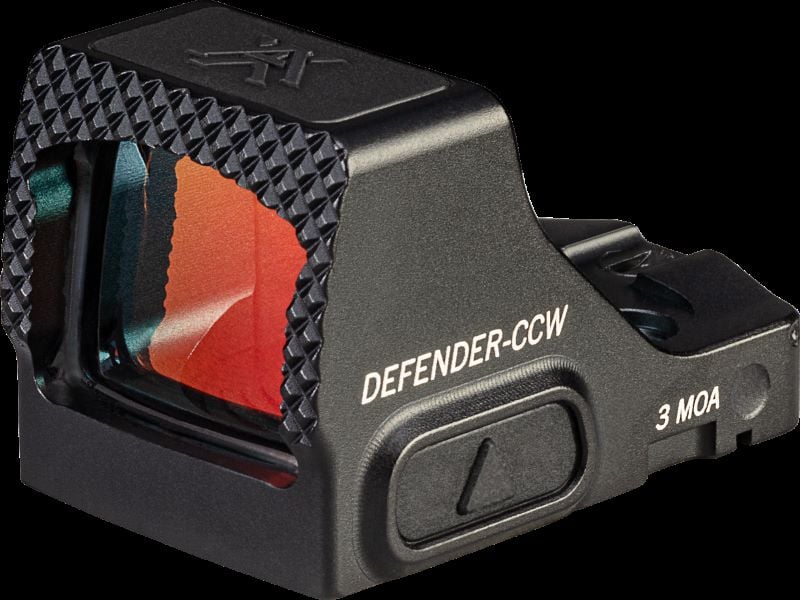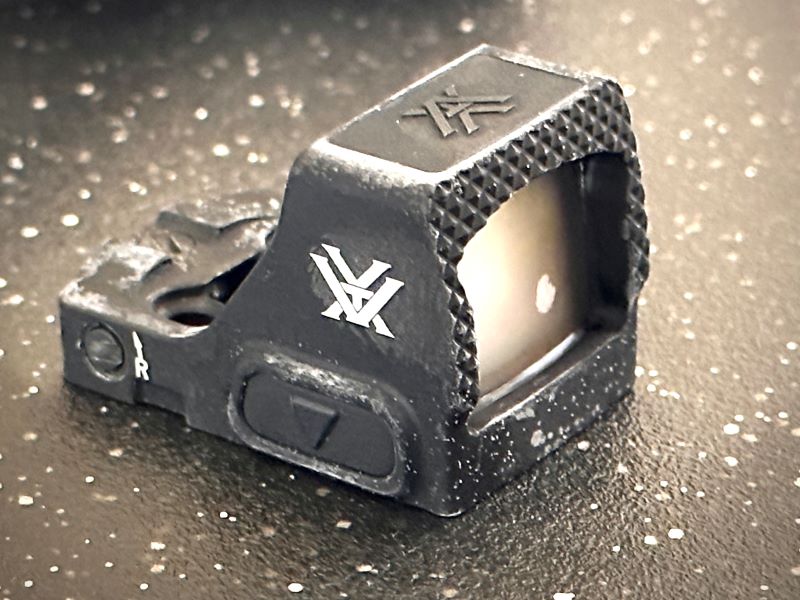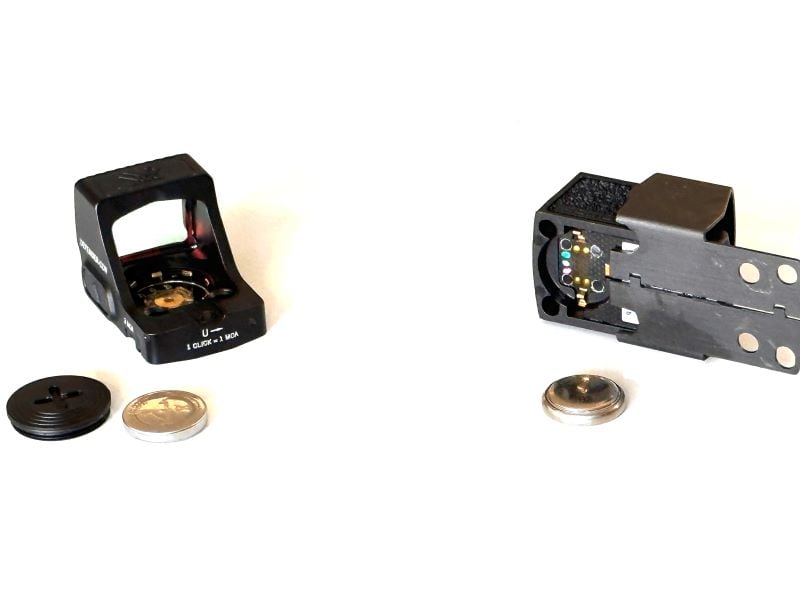The new Vortex Defender CCW red dot is not just another average micro-optic for handguns, PCCs, or sub-guns. It has some improvements that make it stand out over other red dot sights on the market. When I review an optic, I like to prioritize what is important in a good reliable optic. The first, of course, is reliability. If an optic is dead on but breaks easily, it’s kind of pointless right? It must be able to withstand the recoil of the gun, time and time again.

It also needs to hold up to the elements that may come raining down on an optic and its user. And by rain, I mean rain, heat, cold, and let’s not forget our friend gravity. Next, I look at, accuracy, ease of operation, and battery life. I have one big pet peeve with almost every micro red dot I have used. The Vortex Defender CCW has addressed this issue earning some big points in my book. I did a full testing and review on this micro red dot to see if it’s the real deal or just another optic with a different name.
About the Vortex Defender CCW
The new Defender CCW is a 6 MOA red dot that is designed for the Shield RMS footprint. It has one of the largest sight windows for this style of optic, comes with a Picatinny mount, and a one-inch shim plate. The battery life is listed at 9,500 hours on setting 6 of the 10 brightness settings. That’s a decent battery life for the CR1632 battery, but where the battery is housed is where the Defender shines.
I normally talk about the battery at the end of my reviews. But this is an important upgrade. The most common place a battery is housed on micro red dots is under the optic. The battery sits on the top of the gun slide with the optic housed over it. This works but does not fare well for water. It also requires taking the optic off the gun to change the battery. The battery on the Defender CCW is secured from the top with a lid that screws down making it easy to change.
On the box, the optic is listed as waterproof. Because it is a self-contained optic, I can now perform a water test which I have not been able to do on other micro-optics. There are some other features and a couple of complaints I have about the Defender that we will cover later. But first, I want to see if this thing really is waterproof.
Water Test
As I said above, most micro-red dots designed for handguns must be mounted on the gun or the battery to be installed. This is because they have no bottom cover to hold the battery in. It also means there is nothing to protect the bottom of the optic from water except the slide of the gun. The Defender has a self-contained battery from the top, so I was able to throw it in water to see if it truly is waterproof.

I dropped the Defender in a glass of water and left it for two hours. I’m not as concerned about how long it can last after that. I wanted to know if it would be safe if dropped in water and it was. I removed the battery to check for any moisture in the compartment and there was none. Grooves on the top of both sides of the optic allow water to run through and underneath the optic. This design is a big help when shooting in the rain.
Hot/Cold and Impact Testing
Vortex doesn’t have a hot/cold range listed for the CCW, or at least none that I could find. They state it can withstand a wide range of temperatures. Most other optics I have tested can withstand heat up to 150° F and well below 0° F. I used those standards to test the Defender and baked it in the oven until it reached 150°. Nothing was melted and everything was working as it should. I checked for zero on the optic before and after the oven test and there was no change.
For the extreme cold test, I left the Defender in the freezer overnight (set at -10° F) and mounted it back onto the Masada S9 to check it while it was still frozen. The glass did fog up for a while, but it cleared right up after thawing out.

Because the optic is small and light, dropping it was not enough weight for a test. I also didn’t want to drop my handgun and scratch it up, so I used a rubber mallet to check the zero settings after impact. I first smacked it from each side while the gun and mounted optic were set on the ground. After a few impacts, I then stood the gun up and landed the rubber mallet directly on top of the unit. I did this several times and then checked for zero and all was still good at this point.
Control Settings
The Defender CCW is not as complicated as some, but it does have settings that will be easy to forget. To turn the optic on, press a button on either side. On the right is an up arrow, and on the left is a down arrow. To turn the optic back off, press and hold the down arrow for five seconds. There is a lock feature that will basically lock the unit on and keep anything from changing. For this setting press and hold the up arrow for three seconds. The optic has motion activation, but it must be in auto shut-off mode for it to work.

To turn on auto shut-off, press and hold both the up and down buttons simultaneously for three seconds. When you do this, the optic will go to its lowest setting and then increase until it reaches the brightest setting. Again, this isn’t complicated, but it is several steps that most people would forget after a short time. If you have more than one optic, it would be hard to remember. I would recommend making a little flash card to keep at home with the instructions for changing the settings.
What makes the Defender CCW stand out?
Vortex put some aggressive texturing on the front of the optic to help with racking the slide. This is a great feature to include on an optic because once a handgun has a red dot, you end up using it to rack the slide back. The texturing helps keep your hand from sliding off, and it adds to the beefy look, which I like.
Some of my other micro-optics have a small set of arrows on the same side which makes it a little hard to adjust them without turning the gun to the side and taking a closer look. I like the single up and down arrow on each side of the optic. The larger buttons make it easy to adjust from a shooting position. There have been times when I went from indoors to outdoors during a search warrant and needed to make a quick adjustment to my optic.
Another nice feature is the large window. For the size of the optic, the large window provides a good sight of view when engaging targets quickly. This aspect makes the Defender CCW one of the best handgun-mounted optics I have used.

As I mentioned above, the battery compartment is on the top instead of the bottom like other optics. I am probably spending too much time talking about the battery, but it has always bugged me that I have to remove the entire optic to replace a battery. If the battery is easier to replace, it could be changed out on a regular basis, and I won’t have to worry about it. Having a long run-time is still preferred, but this is a game-changer for me.
What I Didn’t Like
There are a couple of things I would like to see different with the Defender CCW. The first is the Auto shutoff time. With an optic on a rifle or some other gun that I wouldn’t be carrying around all the time, 14 hours is fine. This saves the battery if I forget to turn it off. But for an optic that is intended to be on a CCW gun, this could be an issue. I carry a gun on me everywhere I go, so the red dot would need to be on the entire time. When I take it off, 14 hours is a big chunk of time I’m not carrying it. This means it would be on all the time if I didn’t turn it off each day. A shorter power-down would be nice to see.
The next issue is the battery life. If an optic will be on all the time, a 9,500-hour battery life will technically still last a year. But I am guessing I will be replacing the battery sooner than this if it never shuts off. A combination of using the brighter settings, being in cold weather, etc. can all have an impact on battery life. The only way I will know for sure is to carry it for a year and see when it dies.
I can’t complain about the CR1632 battery however without bringing up the battery compartment again. This optic is about as easy as it gets when it comes to changing the battery. They hit a home run with the design of this red dot. A larger battery may not be possible because of the size of the optic, and who knows, maybe it will make it the full year.
My Final Thoughts on the Vortex Defender CCW
The Vortex Defender CCW has a lot going for it. There were a couple of things I would prefer to be different, but these are not deal-breakers for me. If the optic will run for a lengthy amount of time, I won’t have any complaints. It held up to the elements while staying zeroed. It is waterproof, easy to adjust, and the window is large for the size of the optic. I used it on my Masada 9S, but it would also fit the Sig Romeo0 platform for the P365 line of guns. It comes with several bags of screws to help mount it to multiple different guns. A Picatinny rail mount is included along with a cover that is easy to slip on and off.
On the range, the Defender CCW performed as expected. I was able to find target acquisition quickly and the red dot was right on point. There are other micro-optics out there that have self-contained batteries, but they are not as easy to access as this one. The large window view, the battery access, texturing on the front, and the accessories that come with this optic make it one of the best optics I have seen to date. After reviewing the Vortex Defender CCW, I have decided to make it a daily carry.


